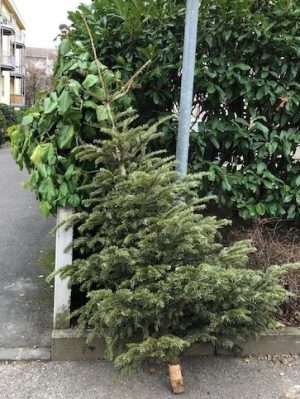The fate of Christmas trees

There is considerable debate as to the virtues or otherwise of buying a real Christmas tree over an artificial one. This comes into focus somewhat more sharply in the post-Christmas period.
A 6 to 7 foot high natural tree (bought with no roots) would be between ten to fifteen years old and it has a fairly low carbon footprint. As it has been growing, it has been absorbing carbon dioxide from the atmosphere and locking it away in the form of cellulose and lignin, whilst releasing oxygen. However, this footprint changes dramatically if its fate is to be consigned to land fill. As it decomposes, it will produce methane, a potent greenhouse gas and the carbon footprint of the tree will increase quite dramatically. If, however, the tree is carefully composted, then its environmental impact can remain relatively low (visit the Carbon Trust for detail).
The cultivation and growth of natural Christmas trees provides a wildlife habitat, and the trees help stabilise and protect soil. But in some parts of the world, notably Canada and the USA, the growth and supply of Christmas trees has been affected by heatwaves (as in Oregon in 2017 / 2018 - which killed many very young trees), insect damage and wildfires. The effects of climate change are particularly marked in Canada. It may be that climate change will intensify the effect of these factors, and that Christmas tree ‘farms’ may need to move to higher elevations - where it is cooler and insect pests (e.g. balsam twig aphid) are less of a problem.
 A artificial tree of similar size to a natural one has a much greater carbon footprint, mainly associated with the production of the different types of plastic (such as polyvinyl chloride) used in its manufacture. PVC may also contain phthalates, which can accumulate in body tissues and are associated with damage to mammalian systems. Whilst artificial trees can be used for a number of years - at the ‘end of their lives’, they are difficult to recycle or repurpose. Plastic discarded into the natural environment is now recognised as a major problem. There is a further consideration - the ‘additional’ carbon footprint associated with the transport of artificial trees from their place of manufacture (often China, South Korea etc).
A artificial tree of similar size to a natural one has a much greater carbon footprint, mainly associated with the production of the different types of plastic (such as polyvinyl chloride) used in its manufacture. PVC may also contain phthalates, which can accumulate in body tissues and are associated with damage to mammalian systems. Whilst artificial trees can be used for a number of years - at the ‘end of their lives’, they are difficult to recycle or repurpose. Plastic discarded into the natural environment is now recognised as a major problem. There is a further consideration - the ‘additional’ carbon footprint associated with the transport of artificial trees from their place of manufacture (often China, South Korea etc).
Further ‘food for thought’ and more detailed information on the pros and cons of natural and artificial Christmas trees :
https://treecanada.ca/blog/why-buying-a-fake-christmas-tree-just-doesnt-cut-it/
https://www.carbontrust.com/news/2013/01/christmas-tree-disposal-advice/
https://theconversation.com/now-that-christmas-is-over-what-are-you-going-to-do-with-your-tree-70448
Comments are closed for this post.
